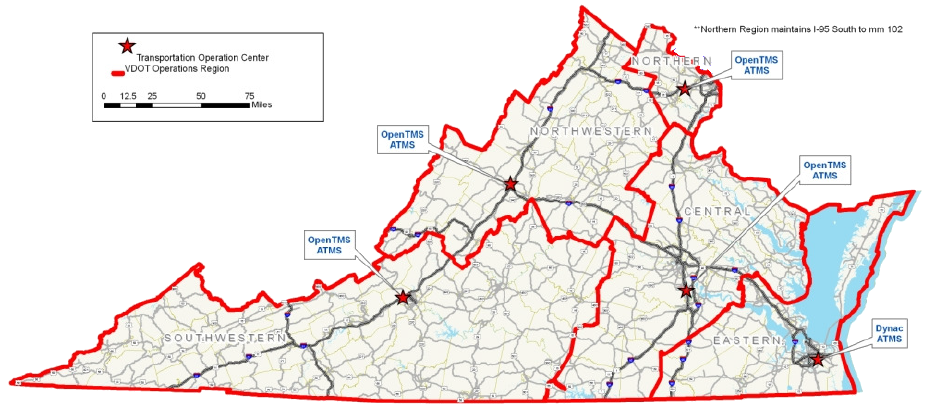Virginia Department of Transportation (VDOT)
"Transportation" is larger than moving cars and trucks, and the Virginia Department of Highways is now the Virginia Department of Transportation (VDOT). In theory at least, the state is flexible in examining the ways to move people and freight. However, to see the state's priorities, it helps to follow the money and see what the tate spend on roads vs. everything else. Highways, after all, are the heritage of the organization:1
- The Virginia General Assembly established the first State Highway Commission in 1906. The original mission of the Commission was, "to maintain, operate, and construct the primary system of highways around the Commonwealth. The first 4,000 miles of Virginia's first highway system was established in 1918. In order to facilitate the allocation of new federal highway funds the General Assembly designated 8 construction districts; those districts remain in place today with one addition, the Northern Virginia District added in 1983.
- The official state agency, the Department of Highways, was established in 1927. By this time the citizens of the Commonwealth had rejected a bond referendum for road construction and instead on the advice of Governor E. Lee Trinkle instituted a "pay as you go" policy that relied on a 3 cent per gallon tax on gasoline for road construction.
- The 1932 Byrd Road Act established a unified State Secondary Road System. This permitted each county to give the responsibility for its secondary roads to the Highway Commission. At the time four counties chose to keep this responsibility including, Warwick, Nottoway, Arlington and Henrico, currently only two remain, Arlington and Henrico. One economist estimated that the Byrd Road Act would reduce rural taxes by $2,895,102 annually, which was certainly Byrd's aim.
- In 1956, Congress authorized the development of a 42,500-mile national interstate system with the first section in Virginia designated for Emporia, the I-95 bypass. To fund the system the federal fuel tax was increased to 3 cents per gallon and the Federal Highway Trust Fund was created. Just a few years later, the findings of a General Assembly highway commission resulted in the authorization of the State's arterial network. This system of four-lane divided highways, in conjunction with the interstate system, would connect, "every city within the Commonwealth of 5,000 people or more and nearly every town having a population of 3,500 - 5,000."
- In 1974 the General Assembly changed the name of the Highway Department to the Virginia Department of Highways and Transportation. It also changed the Highway Commission to the Virginia Highway and Transportation Commission and added two at-large members, one urban and one rural, increasing the membership from 9 to 11.
- The addition of the Northern Virginia construction district in 1984 also created an extra member on the Highway and Transportation Commission. The Commission's name was changed again in 1985 by the General Assembly to become the Virginia Highway and Transportation Board.
- As a result of the 1986 Commission on Transportation in the 21st Century, the General Assembly created the Transportation Trust Fund along with a series of innovative financing tools, they also changed the name of the Department to the Virginia Department of Transportation and added three at-large members to the newly named Commonwealth Transportation Board. At least two of the at-large members were to be from urban areas and at least two from the rural areas.
- In 1990 the Board gained one additional member with the designation of the Secretary of Transportation as the Chairman by the General Assembly. New federal funds were authorized in both 1991 and 1998 with new and innovative financing tools and greater emphasis on planning, public participation, environmental impacts, and multi-modality. Following these new trends, the General Assembly passed the Public Private Transportation Act in 1995 that expanded the role of the private markets in transportation building in the Commonwealth.
The Virginia Department of Transportation is a large organization, requiring lots of equipment and employees to maintain the third-largest number of road miles among the states - even though 35 states are larger than Virginia.
Concentrating resources in the state organization, rather than fragmenting equipment and personnel across 95 county governments, provides greater flexibility for tackling individual problems in different areas. The tradeoff is that Southwest Virginia residents can complain that too much funding is going to Hampton Roads or Northern Virginia projects, while those wealthier regions complain that they are subsidizing development in rural areas with urban-derived income taxes. The usual political response is to increase funding for everyone, to mute the complaints for awhile.
The state agency does not make its construction decisions in a vacuum. It is sensitive to priorities of the public and elected officials, especially members of the General Assembly. The composition of the Commonwealth Transportation Board and the minimum funding required to be allocated to the nine districts ensures that voters always will see some highway construction projects in their region.

VDOT established 5 operation regions with Transportation Operation Centers for Advanced Transportation Management Systems,
rather than rely upon the traditional boundaries of the nine highway districts
Source: Virginia Department of Transportation, Request for Information (RFI) #106-FH-12
Links
References
1. "Interim Report," The Governor's Commission On Transportation Policy,, December 1, 1999, p.13, https://rga.lis.virginia.gov/Published/1999/RD2/PDF (last checked February 2, 2020)
Highways in Virginia
Transportation Patterns in Virginia
Virginia Places
